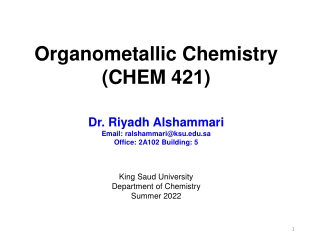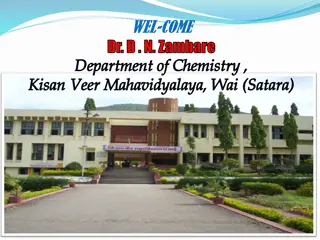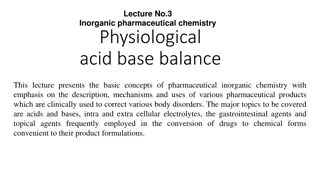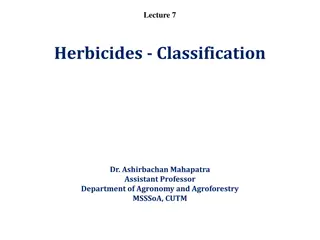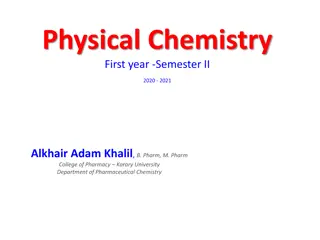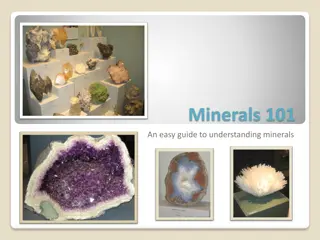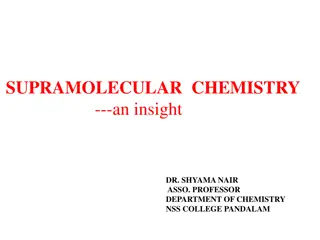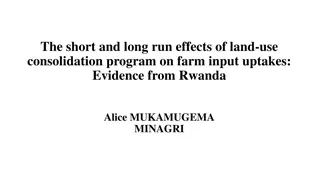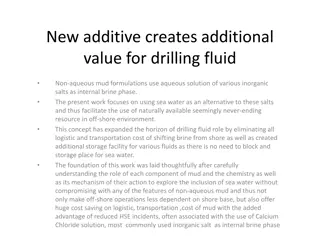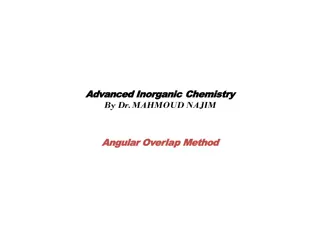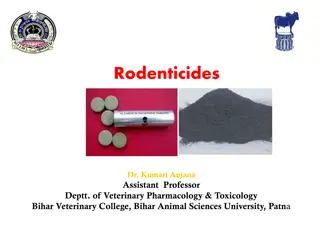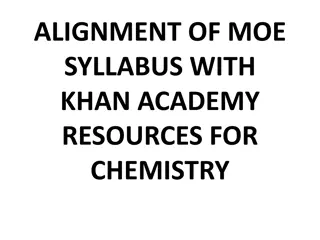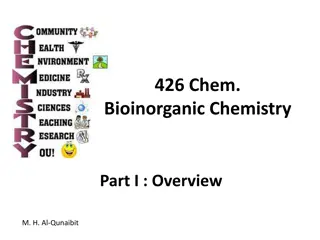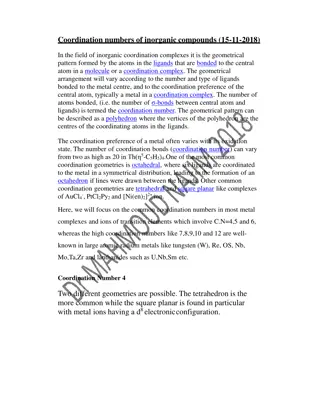Inorganic chemistry
Inorganic chemistry explores the quantized nature of energy states in atoms, where fixed quantities of energy, known as quanta, are emitted or absorbed. This concept is exemplified in the photoelectric effect, where photons interact with electrons on the surface of metals, leading to electron emission. Additionally, the discussion delves into the work function, threshold frequency calculations, and atomic spectra, distinguishing between emission and absorption spectra. These fundamental principles shed light on the behavior of matter at the atomic level.
Download Presentation

Please find below an Image/Link to download the presentation.
The content on the website is provided AS IS for your information and personal use only. It may not be sold, licensed, or shared on other websites without obtaining consent from the author.If you encounter any issues during the download, it is possible that the publisher has removed the file from their server.
You are allowed to download the files provided on this website for personal or commercial use, subject to the condition that they are used lawfully. All files are the property of their respective owners.
The content on the website is provided AS IS for your information and personal use only. It may not be sold, licensed, or shared on other websites without obtaining consent from the author.
E N D
Presentation Transcript
Inorganic chemistry By Dr Sarab Alazawi
Work function Any object (including atoms) can emit or absorb only certain quantities of energy is quantized, it occurs in fixed quantities, rather than being continuous. Each fixed quantity of energy is called a quantum atom changes its energy state by emitting or absorbing one or more quanta of energy. Surface electrons are bound to metals with a small amount of energy. Some of the incident photons enter the surface, collide with atoms of the metal and are totally absorbed. They give their energy to an electron, which, if the absorbed energy was great enough, then break free from the atom. The photoelectric effect is the result of collisions between photons and electrons that knock the electrons out of the metal. Figure 8 W = work function: the minimum energy which is required to remove an electron from the surface of given solid usually metals. E photon = W + E (kinetic energy) ..1 = 2 and E= h . 3 then substituted in (1) Ek = *v - W .4 Ek = mv2 .. 5 substituted in (4) equation mv2= *v - W 6 = c/ .. 7 mv2= hc/ - h 8 h = h c/ mv2 12 = c/ - mv ^2/2h 13 Where = threshold frequency m= mass of electron =speed of electron Figure 8: kinetic energy of photon and threshold frequency Note If E of photon < W work function that means the electron could not move from metals If E of the photon = W the electron move from metal without generate current If E of photon > W the electron move from metal surface and generate current Threshold frequency
Ex (1):When light of a wavelength of (125 nm) strikes a certain metal, electrons having a velocity of (8.2 105 m/s ) are emitted from the surface of the metal. What is the threshold frequency of the metal? = c/ - mv ^2/2h 13 = (3 10 ^8 m/s)/(125 10 ^(-9 ) m)- (9.109 10 ^(-31 ) kg)(8.2 ( 10 ^5 m)/s)2/(2 (6.626 10 ^(-34) J.s)) =1.94 10 ^15 s-1 or Hz Note: J = Kg.m2.s-2 = g. cm2. S-2 Ex (2): An experimenter finds that no photo electrons are emitted from tungsten unless the wavelength of light is less than (270 nm). However, in order to carry out her experiment she needs to produce photo electrons with a maximum kinetic energy Kmax =2.0 eV. What frequency of light should be used to illuminate the tungsten? w = * w = *c/ w = ((6.626 10 ^(-34 ) J.S)(3 10 ^8 ms-1))/(270* 10 ^(-9 ) m)= 7.36 10 ^(-19) J Ekmax = 2.0* 1.6022*10-19 J = 3.2*10-19J E photon = 7.36 *10-19 + 3.2*10-19J= 10.56*10-19 J E= * = E/ = 10.56*10-19 / 6.626*10-34 J.s = 1.56*1015 s-1 or Hz
Atomic Spectra Atomic Spectra of elements can be made to emit energy by subjecting them to electric discharge or by heating are not continuous (discontinuous). The spectrum of atoms consists of sharp well-defined lines or bands corresponding to definite frequencies. There are two types of atomic spectra. (i) Emission spectra (ii) Absorption spectra. 1- Emission spectra Emission spectrum can be defined as a spectrum of the electromagnetic radiation emitted by a substance. This occurs when atoms travel from higher energy level to lower energy level. The emission spectrum is unique to a substance 2- Absorption Spectra The absorption spectrum is obtained when the substance absorbs the radiation. This formed when atoms or molecules are excited from lower energy level to higher energy levels. The comparison between emission and absorption spectrum
The emission or absorption spectrum is included of three types. 1. Continuous spectrum 2. Line spectrum- atomic spectra 3. Band spectrum- molecules spectra Note: Continuous spectrum contains no gaps whereas line spectrum contains many gaps
Emission spectra of hydrogen atom When a high potential is applied to hydrogen gas at low pressure in a discharge tube, it starts emitting a bright light. It is separated into several radiations and forms a spectrum upon passing through a prism or grating. The spectrum consists of separate lines corresponding to different wavelengths. This is called Hydrogen atomic spectrum. The spectral lines are formed due to electronic transitions from one energy level to another. These lines are divided into five series according to the range of wavelengths as follows. Spectral series region 1. Lyman series _ _ _ Spectral n1 n2 2,3,4,5,6,7,_ Ultra-violet 1 2. Balmer series 3,4,5,6,7,_ _ _ _ Visible 2 3. Paschen series near infra- red 4,5,6,7,_ _ _ _ 3 4. Brackett series infra-red 4 5,6,7,_ _ _ _ 5. Pfund series far infra-red 5 6,7,_ _ _ _
The wave numbers of spectral lines in each series can be calculated using Rydberg's equation as follows. = 1/ =R _H (1/(n_1^2 ) - 1/(n_2^2 )) Where n1and n2 are the principal quantum numbers of orbits corresponding to the electronic transition. Where always (n2 > n1). RH = Rydberg's constant = R = (109678 cm-1). Note: Every element has its own characteristic line spectrum. There is regularity in the line spectrum of each element. These spectra can be considered as the finger prints of elements. Hydrogen has the simplest line spectrum among all the elements. The line spectra become complex with increase in atomic number of the element. It can calculate the energy of electron in any orbit by equation E_n=R_(H ) ( Z^2/n^2 ) RH constant has another value like RH= -2.18*10-18J/atom RH= -13.6 e.v/atom The energy change of the electron between two orbits according to the equation below E= E_(n_2 )-E_(n_1 ) E= -2.18 10 ^(-18) (1/(n_f^2 )-1/(n_i^2 )) J/atom E= 13.6(1/(n_1^2 )-1/(n_2^2 )) eV/atom
Example: determine the wave length, frequency and energy of the fifth line of Lyman series and the third line of Balmmer series. 1- =R_H (1/(n_1^2 ) - 1/(n_2^2 )) n1= 1 n2 = 1+5= 6Wave number = 109678(1/12 - 1/62) = 3046.47 cm-1= 1/ = 32*10-5 cm 2- v=c/( ) 3- E=hv Balmmer series n1= 2 n2= 2+3= 5 =R_H (1/(n_1^2 ) - 1/(n_2^2 )) =109678 cm ^(-1) (1/2^2 - 1/5^2 )= 23032.38 cm ^(-1) Example: A Hydrogen atom initially in its ground state i.e., n= 1 level, absorbs a photon and ends up in n= 4 level. What must have been the frequency of the photon? Now the electron makes spontaneous emission and comes back to the ground state. What are the possible frequencies of the photons emitted during this process?. (h = 4.14*10-15 e.V). E= 13.6(1/(n_1^2 )-1/(n_2^2 )) eV/atom E= -13.6(1/(n_f^2 )-1/(n_i^2 )) eV/atom hv= -13.6(1/(n_f^2 )-1/(n_i^2 )) eV/atom v= (-13.6)/h (1/(n_f^2 )-1/(n_i^2 )) eV/atom v= (-13.6)/(4.14 10 ^(-15) ev) (1/(4_^2 )-1/(1_^2 )) eV/atom v= -3.28 10 ^15 (1/16-1/1)Hz v=-3.28 10 ^15 ((-15)/16)Hz v=3.08 10 ^15 Hz Note 1 erg =1.0 10-7 joules E(eV) = E(J) 6.24 * 1018 1 eV/1.6 x 10-19 = 1 Joule 0.625 x 1019 eV = 1 Joule (eV) = 1.602 x 10-19 J E(J) = E(eV) 1.602 * 10-19
Bohrs theory of the atom Bohr s model is shown in Figure 3.1. An electron of charge e and mass m moves around a heavy nucleus of charge +e. ordinarily the electron would move in a straight line, but the attraction of the nucleus bends its path so that it moves with a constant velocity v in a perfect circle of radius r around the nucleus. The situation and the mathematics are very similar to that of a planet arcing round the sun. The major difference is that instead of the force of gravity there is an electrostatic force of attraction FE between the proton and the electron described by coulomb' law: ?? ? ?????????= ??? The movement of an electron in its orbit would create a centrifugal force, which gives it a tendency to fly away from the nucleus. This force is given by ????????????=??? ? ? F_centrifugal=f_columbic ??? ? + ??? = 0 ?? ??? ? = ??? ?? ? Figure 3.1: Electron movement ???= ??? ? ?
An electron has two energies potential and kinetic energy. ??= ?2 ??= ? ? ..5 ???? ? Total energy is ? = ??2 ??2 2 ? ??2 2 = ? +?2 ? 7 Substituted 4 in 7 ??2 ??2 1 8 ? = 2 ? ? 2 ??2 ? = 1 9 ? In order to predict the right frequencies for the lines in the hydrogen spectrum, Bohr found that he had to assume that the quantity (called angular momentum), mvr, can only take on certain values, which are whole- number multiples of h/2 ; mvr= nh/2 .10 n = 1, 2, 3, ..., r = radius of orbit ??2 2 4?2?2?2= ??2 ? v= nh/2 mr ---------11 If the equation 11 substituted in ----3 In order to calculate the radius of orbit by this equation ???? ??????? ? =
Assumption of Bohr's theory 1. The H atom has only certain energy levels, which Bohr called stationary states. Each state is associated with a fixed circular orbit of the electron around the nucleus. The higher the energy level, the farther the orbit is from the nucleus. 2. The atom does not radiate energy while in one of its stationary states. Even though it violates principles of classical physics, the atom does not change energy while the electron moves within an orbit. 3. The atom changes to another stationary state (the electron moves to another orbit) only by absorbing or emitting a photon. Ex: use the Bohr's theory to calculate the first orbit radius of hydrogen atom. ZH= 1 , ZHe = 2, ZLi= 3 ???? ??????? ? = ?? (?.??? ?? ?????.?)? ? ?.?? ?(?.? ?? ???)(?)(?.? ?? ???.?.?)? ? = r = 0.529 10-8 cm ?.?.? = ????/????/?.



